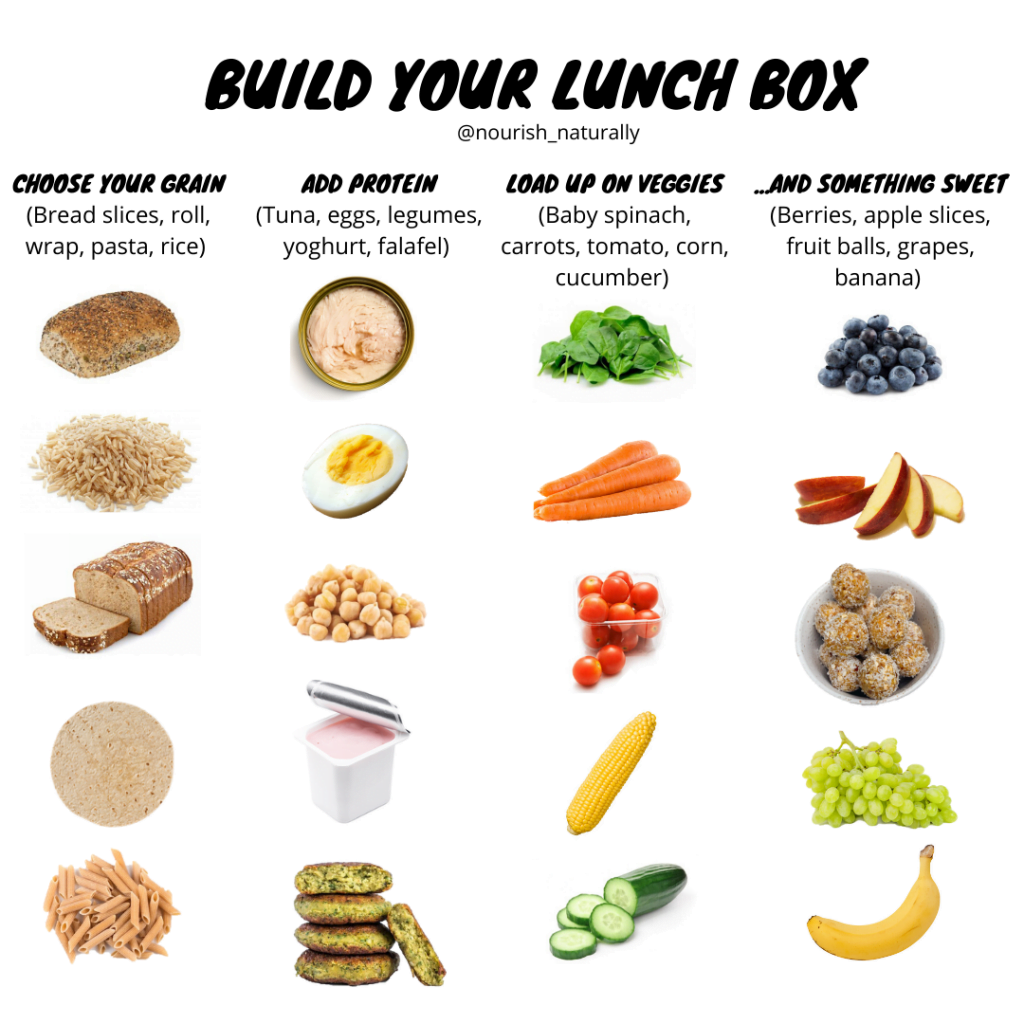Giving your kids healthy and varied lunches that they will enjoy can be extremely challenging! Optimising kids’ health through nutrition is essential. Children need adequate nutrition not only for healthy growth and development, but to maximise learning, energy, and concentration. Over 6 hours of thinking, running around and creating can be draining for little ones, so it is important that during breaks, children refuel with healthy and nutritious food.

NUTRITION FOR KIDS
The key to providing a well-rounded, balanced lunch for your children is ensuring they are consuming a variety of delicious foods from the 5 key food groups, as outlined in the Australian Guide to Healthy Eating. These 5 groups are:
- Vegetables and legumes/beans: provide an abundance of vitamins, minerals, dietary fibre and phytonutrients to ensure that long-term health and immunity is maintained.
- Legumes, beans, lentils, fish, eggs, tofu, nuts, seeds, lean meats and poultry, fish, eggs, tofu: provides an excellent source of vitamins, minerals, particularly iron needed for concentration, and protein to build, maintain and repair body tissues, muscles and organs. Adequate sources of protein are vital for children as they progress through rapid growth and change.
- Grain (cereal) foods: aim to choose wholegrain varieties to sustain energy throughout the day and increase dietary fibre intake. Limit intakes of refined grain products (i.e. cakes, cookies, biscuits) as they are usually high in saturated fats, sodium and sugar.
- Fruit: an excellent source vitamins and minerals, dietary fibre, and phytonutrients, to ensure that long-term health and immunity is maintained.
- Dairy and/or dairy alternatives: This food group provides excellent sources of calcium and protein, essential for building strong and healthy muscles and bones, whilst keeping kids feeling fuller for longer!
RECOMMENDED SERVES FROM THE 5 FOOD GROUPS FOR CHILDREN
| Dairy and/or dairy alternatives | Fruit | Grain (cereal) foods | Lean meats, poultry, fish, eggs, tofu, nuts/seeds and legumes/beans | Vegetables and legumes/beans | *Discretionary | |
| Toddler | ||||||
| 1-2 | 1 – 1 ½ | ½ | 4 | 1 | 2-3 | – |
| Boys | ||||||
| 2-3 | 1 ½ | 1 | 4 | 1 | 2 ½ | 0 – 1 |
| 4-8 | 2 | 1 ½ | 4 | 1 ½ | 4 ½ | 2 ½ |
| 9-11 | 2 ½ | 2 | 5 | 2 ½ | 5 | 0 – 3 |
| 12-13 | 3 ½ | 2 | 6 | 2 ½ | 5 ½ | 0 – 3 |
| 14-18 | 3 ½ | 2 | 7 | 2 ½ | 5 ½ | 0 – 5 |
| Girls | ||||||
| 2-3 | 1 ½ | 1 | 4 | 1 | 2 ½ | 0 – 1 |
| 4-8 | ½ | 1 ½ | 4 | 1 ½ | 4 ½ | 0 – 1 |
| 9-11 | 3 | 2 | 4 | 2 ½ | 5 | 0 – 3 |
| 12-13 | 3 ½ | 2 | 5 | 2 ½ | 5 | 0 – 2 ½ |
| 14-18 | 3 ½ | 2 | 7 | 2 ½ | 5 | 0 – 2 ½ |
NHMRC (2015) ‘Recommended number of serves for children, adolescents and toddlers’, Accessed from: https://www.eatforhealth.gov.au/food-essentials/how-much-do-we-need-each-day/recommended-number-serves-children-adolescents-and
HOW TO BUILD A HEALTHY LUNCHBOX
Coming up with new ideas to include in your kid’s lunchbox can understandably be exhausting, and is definitely easier said than done. I have come up with an easy to follow guide to mixing up your kid’s lunch, while ensuring that they are still consuming a healthy, balanced and sustaining meal.

TIPS FOR PARENTS TO GET KIDS TO EAT THEIR FOOD
Some kids can be fussy eaters, and you may go to the effort of making their lunch box extra healthy, to only receive half of it back, uneaten. To ensure your child maximises their nutrient intake during the day, here are some tips to ensure that your kids bring home an empty lunch box!
- Purchase a compartmentalised lunchbox to make room for colour, variety and abundance. This allows room to keep all foods separated, allows room to mix and match food varieties and to include all 5 food groups into the one lunch box.
- Take your kids shopping with you and get them in the kitchen. By allowing your kids to pick and choose their favourite healthy foods to include in their lunches, this will maximise their chances of consuming something they love. Also, including them in the lunch making process contributes to a positive relationship with food, so they may be more likely to consume something associated with happy memories.
- Don’t pack the same thing – kids can easily get bored with the same foods day after day. Mix around different combinations of grains, veggies and fruits and be experimental! Facilitate your child’s exploration and try incorporating different colours, shapes, sizes and textures within the lunch box to aid in sensory development.
If you’re needing some inspiration for healthy kids snacks for after school and on the weekend, click here.
Article contribution by Nutritionist Tahlia Claringbold from the Nourish Naturally team.

